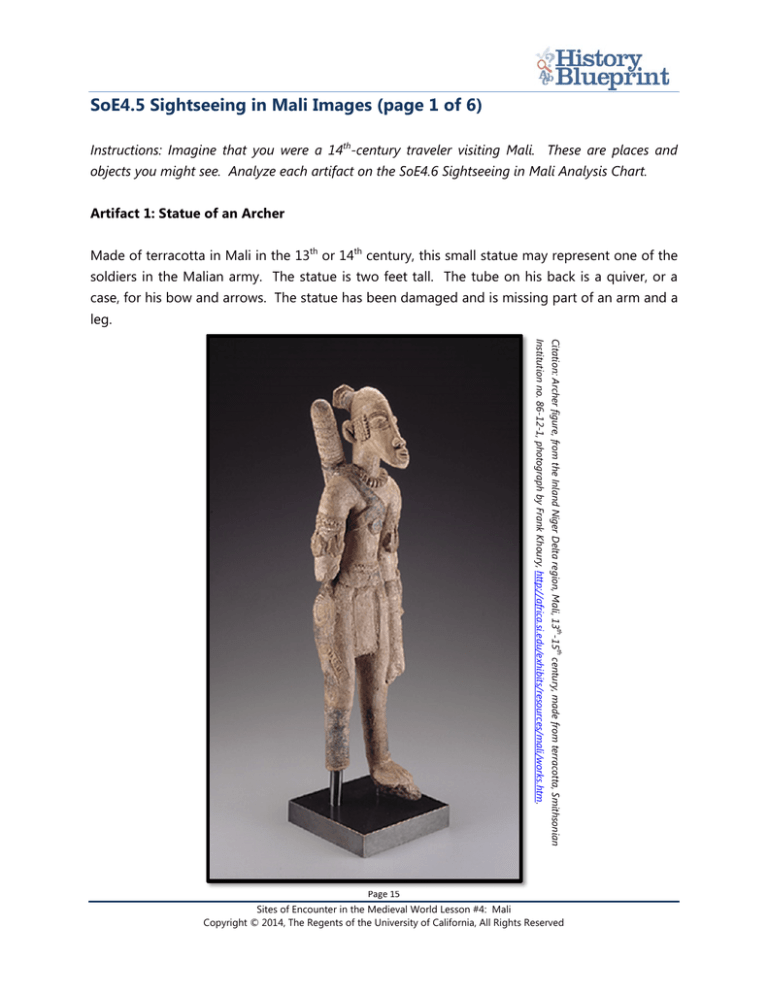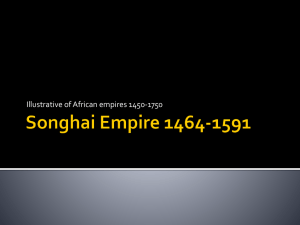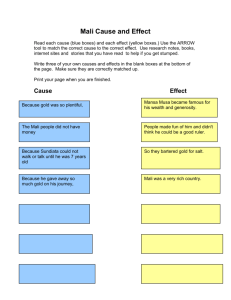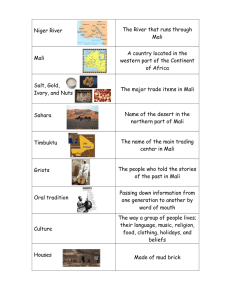
SoE4.5 Sightseeing in Mali Images (page 1 of 6)
Instructions: Imagine that you were a 14th-century traveler visiting Mali. These are places and
objects you might see. Analyze each artifact on the SoE4.6 Sightseeing in Mali Analysis Chart.
Artifact 1: Statue of an Archer
Made of terracotta in Mali in the 13th or 14th century, this small statue may represent one of the
soldiers in the Malian army. The statue is two feet tall. The tube on his back is a quiver, or a
case, for his bow and arrows. The statue has been damaged and is missing part of an arm and a
leg.
th
Citation: Archer figure, from the Inland Niger Delta region, Mali, 13 -15 century, made from terracotta, Smithsonian
th
Institution no. 86-12-1, photograph by Frank Khoury, http://africa.si.edu/exhibits/resources/mali/works.htm.
Page 15 Sites of Encounter in the Medieval World Lesson #4: Mali
Copyright © 2014, The Regents of the University of California, All Rights Reserved
SoE4.5 Sightseeing in Mali Images (page 2 of 6)
Artifact 2: Sankore Mosque, once Sankore Madrassa, or the University at Timbuktu
Built in the early 15th century, this mosque was once the center of a large Muslim scholar community, often called the University of
Timbuktu or the Sankore Madrassa. It was organized into separate colleges, each run by one teacher.
Students studied with that
one teacher to learn the Quran and Islamic religion, logic, astronomy or history. The university was known and respected throughout
the Muslim world.
Citation: Sankore Mosque in Timbuktu, Mali, photograph by Senani P, 2006, Wikipedia Commons,
http://en.wikipedia.org/wiki/File:Timbuktu_Mosque_Sankore.jpg Page 16 Sites of Encounter in the Medieval World Lesson #4: Mali
Copyright © 2014, The Regents of the University of California, All Rights Reserved
SoE4.5 Sightseeing in Mali Images (page 3 of 6)
Artifact #3: A Mathematics and Astronomy Book from Timbuktu
This photograph shows two pages from a book about math and astronomy surviving in Timbuktu. It is an example of as many as
700,000 manuscripts (hand-written books and documents) from the 12th through the 17th century collected by scholars in Timbuktu.
The scribe wrote the book in Arabic.
Citation: The Timbuktu Manuscripts II – Mathematics, Astronomy, photograph by the EurAstro Association, Mission to Mali, led by
Siaka Konaté and Jean-Luc Dighaye, 2007, www.eurastro.de/missions/mali07/mali07.html
Page 17 Sites of Encounter in the Medieval World Lesson #4: Mali
Copyright © 2014, The Regents of the University of California, All Rights Reserved
SoE4.5 Sightseeing in Mali Images (page 4 of 6)
Artifact 4: Great Mosque of Djenne (Jenne)
This Great Mosque of Djenne is not the original mosque that stood on this site. It was built in 1907 to be a close copy of the original
which was then in ruins. The original Great Mosque of Djenne was built in the 13th century by Koy Konboro, a chief or small king of
Djenne who had converted to Islam. Like the original, this mosque is 4 stories high with minarets that are 60 feet high. It was built
of blocks of rice husks, earth and water. The builders put ostrich eggs on top of the minaret spires as symbols of good luck and
fertility. Every year thousands of people work at replastering cracks in the walls. If they stopped, the mosque would disintegrate
quickly.
Citation: Great Mosque of Djenne, photograph by Andy Gilham, at
www.andygilham.com, 2003, Wikipedia Commons,
http://en.wikipedia.org/wiki/File:Great_Mosque_of_Djenn%C3%A9_1.jpg.
Page 18 Sites of Encounter in the Medieval World Lesson #4: Mali
Copyright © 2014, The Regents of the University of California, All Rights Reserved
SoE4.5 Sightseeing in Mali Images (page 5 of 6)
Artifact 5: Statue of a Malian Soldier on Horseback
An unknown artist made this small statue in Mali in the 13th or 14th century. It is just over two
feet tall and made from terracotta. Since horses were not native to West Africa, the Malian
mansas, or kings, had to import horses from North Africa. It was much more difficult to take
care of horses in the desert and tropical climates of West Africa. For that reason, the Malian
army’s cavalry, or soldiers mounted on horses, was one of the most impressive and expensive
projects Mali paid for with its gold. The arms of the figure are missing.
th
Citation: Equestrian Figure, Inland Niger Delta region, Mali, 13 ‐15 century, photograph by Franko Khoury, terracotta, 27‐3/4”, Smithsonian Institution no. 86‐12‐2, http://africa.si.edu/exhibits/resources/mali/works.htm th
Page 19 Sites of Encounter in the Medieval World Lesson #4: Mali
Copyright © 2014, The Regents of the University of California, All Rights Reserved
SoE4.5 Sightseeing in Mali Images (page 6 of 6)
Artifact 6: Doors of the Sidi Yehia Mosque, part of Sankore University or Madrassa in Timbuktu
These doors opened onto a courtyard, where many classes were held at the University of Timbuktu. A carpenter made the doors of
wood and decorated them with ironwork symbols. Notice the crescent moons on the center door.
Citation: Portées de la Mosquée de Sidi Yehia, Toumbouctu [Doors of the Sidi Yehia Mosque, Timbuktu], Sankore Madrassa, photograph by KaTeznick, 2005,
Wikipedia Commons, http://en.wikipedia.org/wiki/File:Medersa_Sankore.jpg.
Page 20 Sites of Encounter in the Medieval World Lesson #4: Mali
Copyright © 2014, The Regents of the University of California, All Rights Reserved





